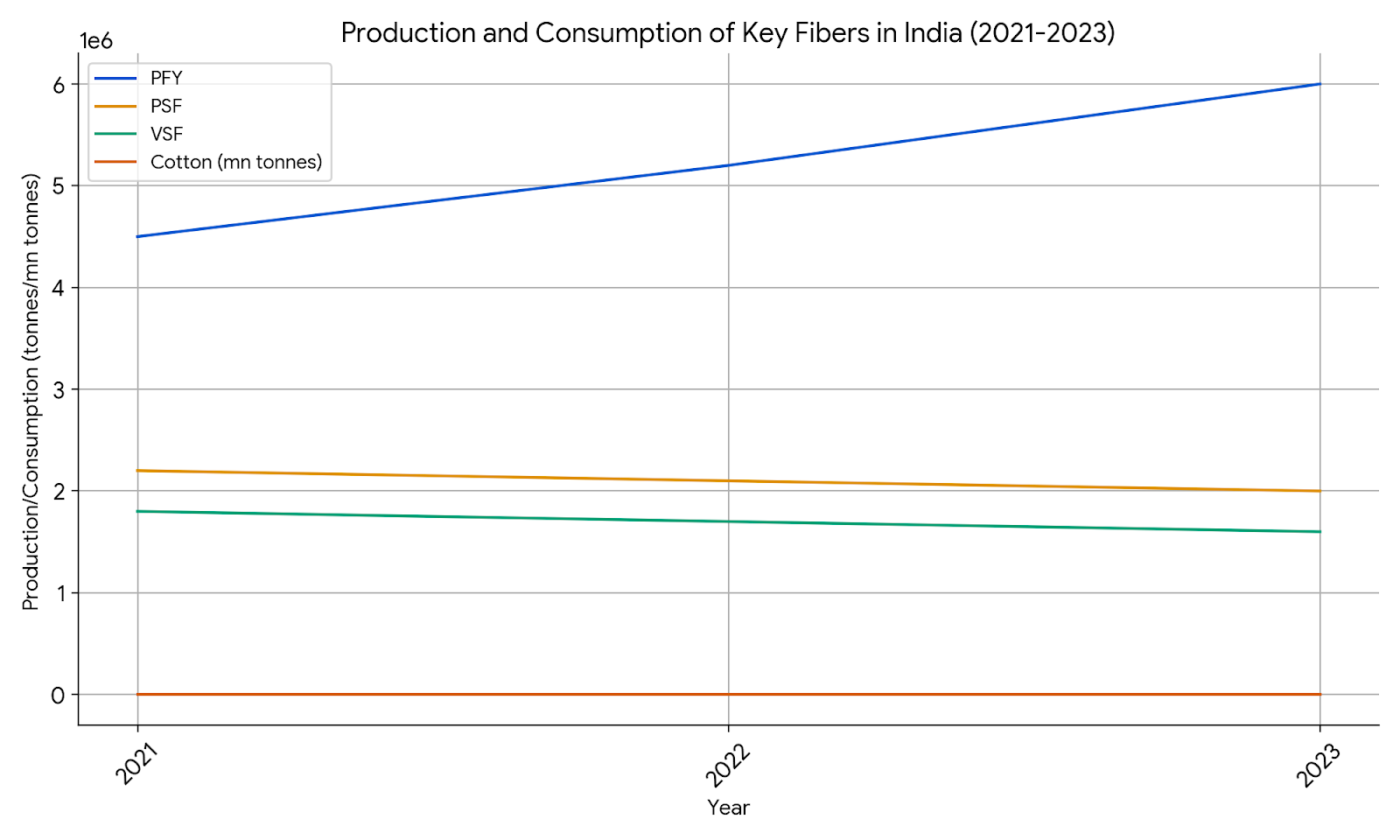Growing demand for polyester filament yarn reshaping India's textile landscape.
Indian textile industry is undergoing a shift, with polyester filament yarn (PFY) taking center stage. Driven by rising demand, economic advantages, and advancements in technology, this trend is not only reshaping the industry but also raising concerns about the impact on other fiber sectors, particularly cotton, polyester staple fiber (PSF), and viscose staple fiber (VSF).
Production and consumption of key fibers in India (2021-2023)
|
Year |
PFY (tonnes) |
PSF (tonnes) |
VSF (tonnes) |
Cotton (mn tonnes) |
|
2021 |
4,500,000 |
2,200,000 |
1,800,000 |
5.5 |
|
2022 |
5,200,000 |
2,100,000 |
1,700,000 |
5.4 |
|
2023 |
6,000,000 |
2,000,000 |
1,600,000 |
5.2 |
Estimated shift in fiber consumption (2021-2023)
|
Year |
PFY |
PSF |
VSF |
Cotton |
|
2021 |
+ |
-5% |
-10% |
-5.45% |
|
2022 |
+15.56% |
-4.76% |
-5.88% |
-3.64% |
|
2023 |
+15.38% |
-5% |
-6.25% |
-3.85% |

Key market drivers
Several factors have worked together to drive up demand and giving a boost to PFY. Some key factors are:
- Fast-Fashion demands:PFY's rapid production and high capacity perfectly cater to the trend of fast-selling seasonal items like summer wear and winter jackets.
- Cost-effectiveness:Technological advancements and affordability make PFY a competitive substitute for other fibers like cotton, nylon, and spandex.
- Continuous production growth:Despite a projected slowdown, PFY production is expected to grow in 2024, solidifying its position.
However, several issues still plague this sector and could be a impediment to growth. For example, increase in polymerization cost. Rising raw material and production costs put pressure on PFY prices, impacting downstream players. Then there is the issue of pre-holiday replenishment. Increased prices have led to reduced pre-holiday stocking, potentially affecting demand. Impact on other fibers and cotton is also another consideration. While PFY thrives, VSF, PSF, and cotton face a drop in consumption, raising concerns about job losses and industry shifts.
Navigating the shift
While PFY's dominance is likely to continue in 2024, the industry must acknowledge the challenges and work towards a smooth transition for all stakeholders. Policy measures and industry initiatives can play a crucial role in supporting the affected sectors and ensuring a sustainable, inclusive future for the textile landscape.
Skilling and reskilling programs: One way is for the government and industry to collaborate and provide training and support to workers transitioning from declining sectors to jobs in PFY or other emerging areas.
Modernization and upgradation: Financial incentives and technical assistance can help existing players in VSF, PSF, and cotton modernize their production processes and adapt to changing market demands.
Diversification and value addition: Encouraging diversification into high-value segments like organic cotton, specialty fibers, and technical textiles can create new opportunities for affected sectors.
Sustainable practices: Promoting sustainable practices throughout the textile value chain, from raw material sourcing to production and waste management, is crucial for the long-term success of all sectors, including PFY.
By adopting a collaborative approach that balances PFY's growth with support for other sectors, the Indian textile industry can navigate this shift responsibly and ensure a thriving future for all its stakeholders.
